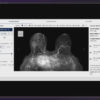Lung cancer is increasing in non-smokers, according to a new European study published in the journal Radiology.
For decades, lung cancer has been predominantly associated with tobacco smoking, but recent trends have spotlighted a concerning rise in its prevalence among non-smokers. This shift challenges our understanding of the disease and underscores the complexity of its origins.
The study analyzed CT scans from over 10,000 participants and found at least one lung nodule in 42 per cent of them.
The U.S. Preventive Services Task Force currently does not recommend lung cancer screening for nonsmokers. However, it does advise annual screening for adults aged 50 or older who have smoked a pack a day for 20 years or two packs a day for 10 years, and either continue to smoke or have quit within the last 15 years.
“Here in the lung cancer community, we’re really trying to de-stigmatize the role of smoking. And we do that by saying if you have lungs, you can get lung cancer,” said Moffitt Cancer Center epidemiologist Matthew Schabath, PhD.
According to the National Institutes of Health, women who have never smoked are twice as likely as men who have never smoked to develop lung cancer.
The rise in lung cancer cases among individuals who have never smoked is driven by environmental, genetic, and possibly unknown factors.
Furthermore, environmental risks like secondhand smoke, radon gas, asbestos, and air pollution significantly contribute to this increase.
As urbanization expands, exposure to polluted air rises, which may partially explain the trend. Genetic mutations also play a crucial role. Research shows that mutations such as EGFR, KRAS, and ALK rearrangements are more common in non-smokers with lung cancer.
Read more: Breath Diagnostics takes aim at lung cancer with One Breath
Read more: Breath Diagnostics pioneers novel lung cancer breath test
Diagnosis isn’t risk free
These mutations can occur naturally over time or result from factors unrelated to smoking. Additionally, the demographics of lung cancer patients are changing. While once primarily linked to smoking, more cases are now appearing in younger people and women who have never smoked.
This shift suggests that lung cancer in non-smokers may represent a different disease entity, with subtypes marked by unique molecular characteristics.
The problem with diagnosis is that it isn’t exactly risk free.
Low-dose CT scans are the standard right now for diagnosis of lung cancer, which are rare, time consuming and don’t come at zero risk. These include exposure to radiation, which can slightly increase the risk of developing cancer over time, particularly with repeated scans.
False positives are also a concern, potentially leading to unnecessary invasive procedures like biopsies or surgeries. Additionally, low-dose CT scans may detect non-cancerous abnormalities, causing undue anxiety for patients.
However, improved diagnostic techniques and increased awareness likely contribute to the reported rise in lung cancer cases. With tools like PET scans and MRIs now more widely used, doctors are detecting more cases in non-smokers that might have previously gone unnoticed or misdiagnosed.
“We need more research,” said Schabath. “We need to bring together cancer centers and universities really across the country, because we need large numbers to identify what we call biomarkers. These are sort of indicators or bookmarks of people who are at a high risk.”
Schabath notes artificial intelligence as a promising tool for analyzing data to better identify who should be screened for lung cancer. The goal is for AI to detect biomarkers or genetic indicators, helping to determine who needs screening and who does not.
Read more: Microsoft and AI company join forces to build cancer diagnosis platform
Read more: WELL Health and Healwell AI join forces to produce more efficient hospitals
More options than low-dose CT
There are plenty of other options in various levels of development.
Several companies are advancing the field of lung cancer diagnosis through innovative technologies. Guardant Health (NASDAQ: GH), for example, specializes in liquid biopsy techniques. These analyze blood samples for genetic mutations and cancer-related biomarkers, improving early detection.
Meanwhile, Oncimmune offers the EarlyCDT-Lung test, which detects antibodies that signal lung cancer before symptoms emerge.
Furthermore, Breath Diagnostics Inc is developing a non-invasive breath test that detects volatile organic compounds (VOCs) called One Breath. It involves giving one full breath to a bag, which captures biomarkers. Performers of the test then transfer the biomarkers to a device called a microreactor, which are then transferred to a lab for thorough analysis.
.
Follow Joseph Morton on Twitter
joseph@mugglehead.com














